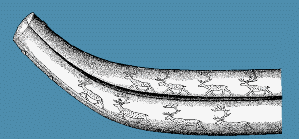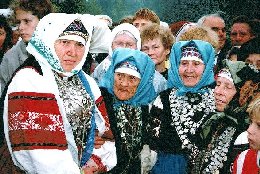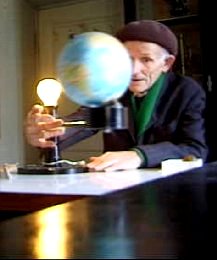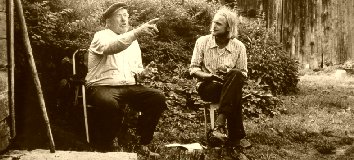Mäetagused vol. 7
Summary
The Mythology of Ob-Ugrians. IV
Aado Lintrop
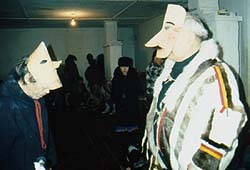 | |

1.2 Mb .mpg |
On the basis of the folklore texts collected by B. Munkácsi, A. Kannisto and W. Steinitz, in four parts of the article (Mäetagused vol. 4 -7) is given a survey of the popular mythological beings of the Mansi and Khanty peoples. The first part of the article begins with the Mansi world creation legend and focuses on the Sky God and his wife or daughter Kaltesh. In the second part, the topic is continued with notices about the mythical golden idol of the Ob-Ugrians. Next, the article concentrates on the most popular deity - World Surveyor Man. In the third part, besides the last mentioned Lord of the Underworld, Sacred Town Elder and Kazym River Mistress are treated. The last part of the article is devoted to the beliefs and customs connected with bears. The majority of text examples were translated by the author from Mansi and Khanty languages.
Relative from Across the River of Blood: Lapp Folk Tales About Totem Reindeer. IV
Enn Ernits
It is made an excursion to other Lapp fairytales depicting people
transforming into animals and marrying them.
In the summarising part of the marrying stories of Meandash, the different and similar traits of all stories are pointed out (tables 5-7). Also, the three possible ideal versions of all the three subtypes are presented. The scarcity of variations and literary influences do not allow wide suggestions about their origin to be made.
The story of Meandash leaving consists of three parts: 1) the misdeed (pissing on a sleeping-skin), what in its turn conists of two subparts, namely a) a reindeer's monition and b) the act; 2) the misdeed is followed by eloping from home and 3) the mother's reaction to this (admonition, threat, joining). The motif of fleeing reasons 1) why the reindeer no longer live with men and 2) how the wild reinder became the Lapps' main food. Thus this is partially an explanatory myth. More closely are analysed the stories I-VI and VIII-X.
On Archaic and Secondary Writing and Cultural Changes
Art Leete
The article connects sensing the landscape and orienting with the notion of a kind of 'sign', 'writing' or 'language'. The connection is formed by an extremly wide and generalised interpretation of these notions.
The primary or archaic writing is culture specific communicative manipulating with environmental differences. Its usage is based on the expected heterogenity, asymmetry and discrreteness principle of space.
Secondary writing is a consensual, traditionally levelled strategy to store and communicate information in a constantly perceived visual form. This ties the notion 'writing' to certin levels of the language structure, a level of normative symbolization, the formation of which is often seen as the emrgence of real writing.
In the course of cultural changes, teh secondary writing is gaining ever more significance, although manipulating natural surroundings remains as an archaic layer of writing also in later communicative techniques.
Cultural identity, nationalism and changes in singing traditions
Kristin Kuutma
The article describes some alterations in singing traditions from the aspect of sociocultural context and viewed from the Estonian perspective, providing a historical and social background of singing traditions, including the survey of the `national awakening' process. As particular occasions where singing traditions in relation to cultural identity are studied, two types of festivals have been chosen: a large national festival and a small community festival.
The festivals studied occurred in the summer of 1994. The National Song Festival was arranged for the twenty-second time, that year exceptionally in two towns, Tartu and Tallinn. The community event was the Setu Kingdom Day, celebrated in Obinitsa village. Festival is observed here as cultural performance, characterized by periodicity and recurrence, by impersonal and predictable movement of time. A festival provides an opportunity to study the external orientation of customs, folkloristic phenomena, transformations in the sociocultural context, organized performance and the functional context of singing. In the contemporary society the use of the song as a tool in life-shaping experiences has been replaced in many cases by a spectator experience.
The Estonian events analysed lead to a conclusion that the functions of the festival as cultural performance are equivalent on the community level and on the national level. The festival provides a scenery for manifestations of cultural and national identity, national and ethnic unity. Complementing the transformations in sociocultural context, the observable phenomenon of uttering political ideas and aesthetic images with musical modulations of the voice (i.e. singing) continues to be a significant mechanism, which affects social behaviour. For example, it may serve as a cultural response to the national desire for independence. One noteworthy process in Estonia has been the alteration of music perception resulting in song festival movement, which in turn has had essential impact on the modern nation-building. The environmental adaptation of the historic tradition can be observed in the versatile expressions of cultural acitivities. In contemporary society the traditional aesthetic folklore is cultivated in organized performance groups.
Uncle Starman
Andres Kuperjanov
A story of a man and his world. In the 1960s he built the science and intersts centre for his village with his own means. In the Tõutsimäe village observatory in Võrumaa, lectures on the universe have been held, stars watched and other events held. With the help of the proportional solar system, anyone can get an overview of the real grandiosity of the universe. Hugo Raudsaar (b 1923) is a professional astronomer. His speciality in the Tartu Observatory used to be identifying the orbital elements of the small bodies of the solar system.
About Conundrums This Way and the Other
Piret Voolaid
The current article is based on material from the file of conundrums of the Estonian Literature Museum's archive, containing approximately 20 000 texts and 1500 types. The material has been stored by the archive since the second half of the 19th century.
Conondrums are quizzes of a relatively certain form (ie. a certain starting formula - an interrogative noun or expression). (For instance How do you understand there is an elephant in the fridge? There are slippers behind the fridge door.) The aim of asking these questions is to make the other a fool and pull his nose, as well as being entertaining.
The neccessity to treat conundrums in a separate study has come forth in present day as the classical quizzes are less known, while its successros - conundrums, word games, puzzles, etc. - are becoming more popular.
Currently the oldest known traditional conundrum originates from the third volume of Rosenplänter's "Beiträge" in 1814. The term conundrums originates probably in M. J. Eisen's 1914 book of puzzles "Mõista, mõista, mis see on ..." ("Guess, Guess What, This Is ...«), where the author names conundrums and word games under the name difficult questions. Throughout history, conundrums have been called with very different names: puzzles, short questions, funny questions, intersting questions, questions by the Armenian radio, joke questions, tricky questions, contemporary puzzles, legpulling questions.
The three more important steps in treating conundrums are:
1. Mattias Johann Eisen discriminates them with a special term difficult questions (Eisen 1914, p 19);
2. Vaina Mälk (Mälk 1959, p 449) and Eduard Laugaste (Laugaste 1975, pp 291) discriminate them as a subtype of puzzles on the theoretical level;
3. Arvo Krikmann in his lecture material treats conundrums as a peripheral part of puzzles (Krikmann 1993, p 3).
Currently, puzzles are treated as a separate genre with some certain characteristics ad teh subgenres of real puzzle, conundrum, etc. The problems are, that
1) the term puzzle has gained two meanings, where the general term has remained puzzle and puzzle in the classical sense is called now simple, classical or real puzzle;
2) conundrums, which used to be in the periphery, has reached the central with the developnt of folklore. (While in the Hurt collection, in the material from the end of the last century, there are only a few conundrums, then the 1992 schoollore competition resulted in only a few classical puzzles. Thus the problem: are conundrums a subtype of puzzles or something entirely different? Contemporary Estonian folklore treats conundrums as a subtype of puzzles. Probably it is not impossible that it will soon be treated as a separate genre.

|
|
3.15 Mb .mp3 |
A New Song
An old incantation arranged by ansambel Võikõllane.
Comments by Aare Laak and Ants Johanson.
Pictures of Setomaa II
Notes of a Traveler. August 19-23, 1996
Mariann Remmel
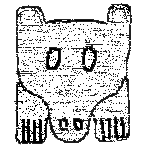 A Legend of the Bear and the Mother of the Por-people
A Legend of the Bear and the Mother of the Por-people
Translated and illustrated by Aado Lintrop.




